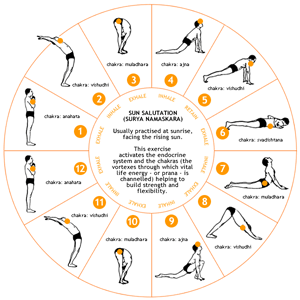My reason for choosing Sun Salutation in particular is that the postures are an ingenious amalgamation of a huge diversity of postures, which includes forward bending poses countered with backward bending ones. Also, Sun Salutation does not need any gadgets or equipments and can be done in a limited frame of time and space.
To start with, I have no clue who discovered the surya namaskar or sun salutation yoga asana since its one of the oldest yoga exercises known to man.
Its origins lie in a worship of Surya, the Hindu solar deity. The exercise has been practiced for centuries and is one of the most popular and well acclaimed yoga postures. The Hatha Yoga Pradipika, the oldest known hatha yoga text does not mention “Sun Salutations” but mentions a sūrya-bhedana (sun-piercing) kumbhaka while the Gheraṇḍa Saṁhitā mentions sūrya-bheda kumbhaka .The oldest documented book with clear depictions of asanas is the Sritattvanidhi, though there is no mention of “Sun Salutations” in the text, it does describe the asanas “Sarpasana” (Bhujangasana), “Gajasana” (Adhomukh Swannasan), “Uttanasana” and series of asanas done in tandem, similar to Sūrya Namaskāra.
The exercise consists of 10 sequences, with each posture counteracting the preceding one, producing a balance between flexion and extension, performed with synchronized breathing and aerobic activity . A number of yoga researchers have analyzed the various benefits of the exercise but there is a need to emphasize on the rightful way the exercise is intended to be executed.
S.N. Omkar, an aerospace researcher at the Bangalore-based Indian Institute of Science (IISc) & the yoga coach of the Indian cricket team — recently demonstrated why surya namaskar is one of the best forms of exercise for the human body. And that’s a claim he supports with his own scientific studies.
According to a study by him [ http://www.worldacademicunion.com/journal/SSCI/SSCIvol06no01paper06.pdf-Journal of Bodywork and Movement Therapies], regularly practising surya namaskar aids in bone formation (osteogenesis) and bone remodelling. The results obtained by analysing sun salutation can be extended to any general biomechanical procedure or activity.
Independent experts agree that performing surya namasakar every day greatly benefits mental and physical well being. But to say that it helps in osteogenesis is slightly far-fetched, they argue.
To prove his point, Omkar developed a mathematical model to tabulate the forces acting on the various joints in the body — such as the wrists, elbows, shoulders, hip, knees and ankles — during the 10 different postures the exercise involves. According to him, no major joint is overstressed during any of the sequences. At the same time, the activity burns calories at rates comparable to those of many rigorous aerobic exercises. For instance, quoting his own earlier work, the IISc scientist says that if a person weighing 70kg does the exercise 120 times at a stretch — and this can be done in around 55 minutes — he or she could burn up to 380 kilo calories, which is almost equal to the energy expenditure in one hour of brisk walking.
The study focused on analyzing the effect of the exercise on specific joints of the body and created a mathematical model for the same. By creating a mathematical model, the effect of the exercise on joints such as the wrist, elbow, shoulder, hip, knee and ankle joints were analyzed. The results of the analysis concluded that the dynamic moments with high magnitudes and rates, applied with unusual distribution patterns, optimal for osteogenesis, were found to occur during the exercise. Also, the joints were subjected to sub maximal loadings thus ensuring that none of the joints were overstressed . Thereby suggesting that, there are no injurious side effects to the joints whilst practicing the exercise for numerous cycles.
Although the world of yoga research is aware of the numerous benefits of the sun salutation exercise, little has been done to dwell deep into the finer nuances of this ancient yoga exercise, such as the method of performing the exercise. Much of the research is focused on the benefits of the exercise but little has been done to ensure that the exercise is performed in the way it is intended to be practiced, that is with graceful movements and consistent repetitions. Although millions across the globe practice this unique prostration exercise for its health benefits, it is only with the right synchrony of breathing and graceful execution can one reap the myriad of benefits the exercise has to offer.

